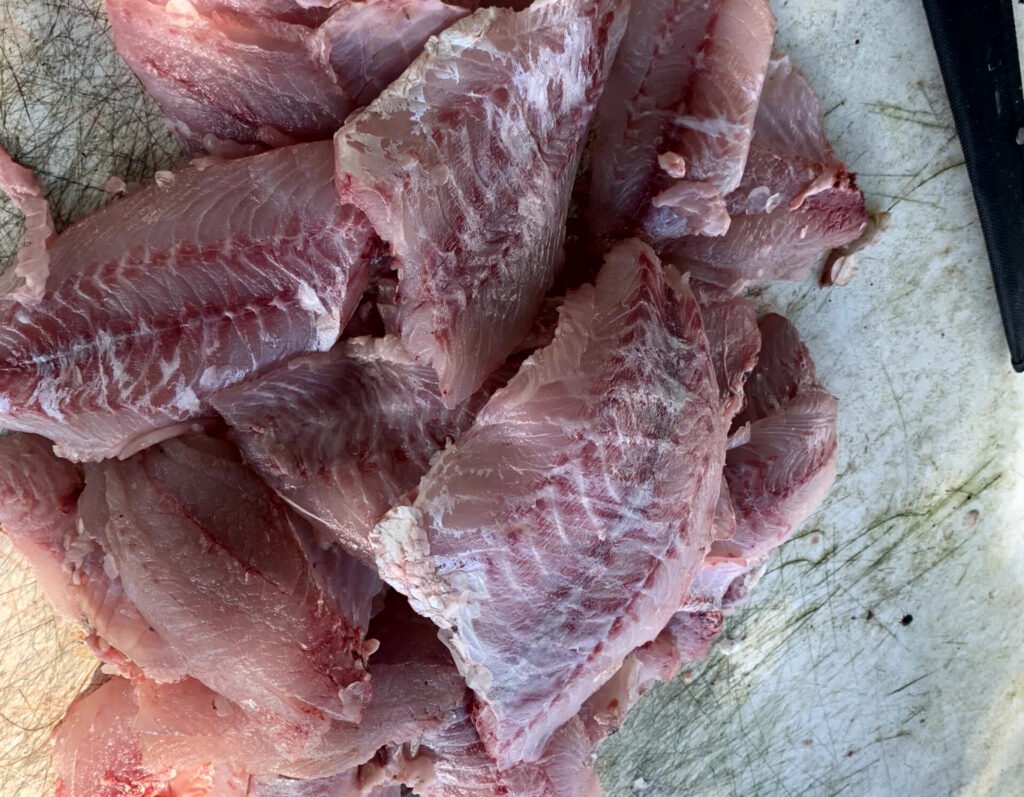
Catching And Cooking Spanish Mackerel
Prized in India and Sri Lanka for its flavor, Spanish Mackerel are sometimes called Seerfish or Seer Fish
Catching Spanish Mackerel

Size and weight: Range from 11″ to 22″, with a maximum size of around 25″. They can weigh between 1 and 3 lbs.
General Info
A relative of Tuna and found pretty much worldwide, Spanish Mackerel are a fun and easy fish to catch. That said, they can be dangerous to handle – with sharp teeth like a lizard fish or an alligator. With a distinctive long nose, they are considered a ‘junk’ or ‘trash’ fish to many, but can be acceptable eating if deep fried.
When/Where
Time of year: Year round fish, but more active in cooler months, but not dead winter. October and November.
Location: Spanish Mackerel are a suspended fish more than a bottom fish. They prefer deeper waters: between 20’ to 25’.
Time of Tide: Dawn or dusk are the best times of day to fish. Their prey – small fish, sand eels, launce, shrimps, squid and so on – are also most active around these times.
How
Bait: Cut bait – greenbacks, shrimp, lady fish.
Method: Reel and rod, with appropriate tackle.
Cooking Spanish Mackerel

Drink Pairings

Drinks: Avoid beer; pairs well with sweet wines and Bourbon (beforehand)
Flavor
Deliciousness: 10 out of 10.
Flavor: Wet fish. Lingering taste that’s not fishy.
Cleaning
Standard cleaning: strike (knife) behind the gill plate, go down along the backbone. You get two filets. Skin both filets.
De-gutting: De-gutting is not necessary if you are cutting fillets – simply cut around the fish guts.
De-blooding: Spanish Mackerel, Redfish, Grouper and Sharks are typically de-blooded.
De-veining: Is recommended for larger fish, including Spanish Mackerel, Redfish, and Sharks.
Cooking
Methods: Would sauté or blacken, or deep fry. Seasoned like Red Fish. Spanish Mackerel don’t taste good if they are not cooked properly.
Dishes: Appropriate for dishes that require fried fish, including tacos.
Traditions: Appropriate for traditions that require fried fish.
Suggested Dishes
Appropriate with standard greens and sides.
Cooking Fish, Generally
Traditions: Plain, Upscale, Southern, Creole, Cajun, Western, Southwestern
Cooking Methods
Sautéed (blackened): use a high-temperature oil with minimal flavor. Avocado, grapeseed, linseed, sunflower, safflower.
Deep Frying: use similar oil to sautéed, but more of it.
Baking: Method 1: Use tinfoil and leave open. Seasoning is household seasonings. Lemon pepper and garlic. When fish is done, you’d use lemon juice and butter. Don’t add butter before the fish is cooked. Method 2: same but close foil.
Grilling: if you want more flaky entrée, low heat. Maybe 10 minutes, both sides. Heavier texture, use a higher temperature.
Dish Descriptions
Entrée: Many people prefer blackened, filet skin on one side and leave skin on the other.
Fish tacos: Require fileting both sides. Cube, deep fry in a batter.
Fish soup or stew: Reheats well. A common cioppino or Cajun recipe will suffice.
Fish salad. Deep fry to keep together, into a crisp. Cover meat halfway full with oil. Cook in a cast iron skillet. Use a Caesar dressing.
Sides: Sweet potato, baked potato, potato wedges, brown rice, hush puppies
Vegetables: Asparagus, broccoli, salad, sliced tomatoes and avocado, string beans, seasoned collards, okra
Appetizers: Ceviche dip and fish cakes.



